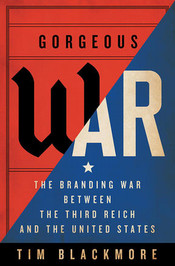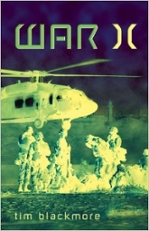 Tim Blackmore
Tim Blackmore
Gorgeous War: The Branding War between the Third Reich and the United States
Gorgeous War argues that the Nazis used the swastika as part of a visually sophisticated propaganda program that was not only modernist but also the forerunner of contemporary brand identity. When the United States military tried to answer Nazi displays of graphic power, it failed. In the end the best graphic response to the Nazis was produced by the Walt Disney Company.
Using numerous examples of US and Nazi military heraldry, Gorgeous War compares the way the American and German militaries developed their graphic and textile design in the interwar period. The book shows how social and cultural design movements like modernism altered and were altered by both militaries. It also explores how nascent corporate culture and war production united to turn national brands like IBM, Coca-Cola, and Disney into multinational corporations that had learned lessons on propaganda and branding that were being tested during the Second World War.
What is the legacy of apparently toxic signs like the swastika?
The answer may not be what we hoped. Inheritors of the post-Second World War world increasingly struggle to find an escape from an intensely branded environment—to find a place in their lives that is free of advertising and propaganda. This book suggests that we look again at how it is our culture makes that struggle into an appealing Gorgeous War. 2019, Wilfred Laurier University Press.
War X: Human Extensions in Battlespace
Are we afraid of war? Has the advancement of military technology created a mindset of invincibility on the battlefield? In War X, Tim Blackmore argues that the technology of warfare has essentially erased the human body from battlespace. The result is a physical and psychological distance between humanity and bloodshed. As the machinery of war develops, and as advances are made in the biological sciences, war becomes increasingly palatable - attractive, even - resulting in a sanitized murder culture in which war is anticipated and viewed with little anxiety.
Blackmore makes connections between human beings in battle and the very different world of weapons manufacturers, finding between the two a romance of war technology. Using popular science fiction literature and film, personal war narratives, biographies, and military imagery, he explores the human body in war, the ways in which soldiers imagine themselves superhuman - posthuman - protected by the armour of muscles and steel, tanks and helicopters, robotics and remote control.
War X is an explosive introduction to the discussion of modern warfare and a timely consideration of industrial warfare as it is unfolding even now in Iraq and Afghanistan, and as it might be in the future, with new weapon development. It is also a deliberation on the startling world of new weapon development, and the indescribable future of war that beckons. 2005, University of Toronto Press.




